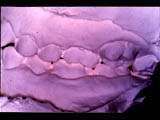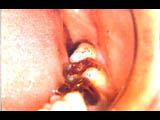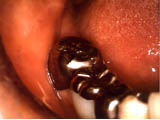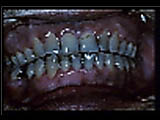|
|
|
|
|
|
|
|
|
|
|
Posture and
Occlusion |
|||

|
1.Severe Migaine Headaches It is probably correct to assume that migraine headaches are due to premature contacts in centric relation. Dynamic premature contacts which arise due to the extrusion of maxillary third molars following extraction of the mandibular third molars are the most common cause of particularly severe symptoms. |
||

|
A woman restaurant owner came to this office with a fractured right maxillary central incisor. Observing extrusion and strong facets on the mesial surface of the right maxillary third molar, I guessed that the patient had migraine headaches on the right side. She reported having migraine headaches for more than twenty years which had become so bad recently that she was bedridden for two days each week. Although she had a complete physical examination twice per year and had the origin of this probrem investigated, she was told that it was probably due to high blood pressure. Following extraction of the right maxillary third molar, the right migraine headaches have not occured once in seven years. Figure 1 shows a typical example where headaches were caused by the extrusion of a maxillary third molar. Also, locking of the maxill ary and mandibular lateral incisors and psalidodontiaof the second molars as shown in figure 2 cause migraineheadaches. |
||
   |
2. Severe Stiff Necks It is probably correct to assume that stiff necks are for the most part due to balancing side interferences. This is why molar disclusion is so important. Opposite from the case of severe migraine headaches, symptoms here will appear when dynamic balancing side interferences occur due to the extruction of the lower third molars when the upper third molars are extracted. Figures 3 and 4 show a ypical case. The common case where a bridge which neglected to consider molar disclusion caused a severe stiff neck may also be said to have been caused by a dentist. The case shown in figure 5 is a typical example. When considering molar disclusion it is best to keep in mind anterior guidance, the curve of Spee, and Wilson's curve. One example is I shown in figure 6. The attrition of the occlusal surface composite restoration in the mandibuar first molar was the cause of back pains in this indivisual. It can probably be said that the dentist created a problem in an area which could easily cause problems in back. |
||
  |
3.Slipped Disks The origin of slipped disks is the same as that of severe stiff necks, i. e. bala-ncing side interferences. Although symptoms usually appear as stiff necks in this case, people who have slipped disks rarely complain of the symptom of having a stiff neck. Age, personality and physical constitution play a role here. Balancing side cuspal interferences over a long period of time cause postural distortions and induce pain in the muscle which pull the pelvis up and back. If muscle imbalances shift the lumbar vertebrae, a hernia can be expected. Muscle fatigue recuperative capacity decreases with age. Also, cuspal interferences gradually become stronger. It appears in different forms such as subacromial bursitis when in the shoulders, a slipped disk when in the hips, numbness in the fingers typists and telephone operators, and tennis elbow in people who like tennis. The situation where a lower first molar is missing and the second and third molars are lingually inclined is a typical case which is very common. Figure 7 is an example of this case. As the effect slowly appeared, distortions arose in the posture and then came to the hips. There are also cases of people with slipped disks who have mandibular third molars etruded on both sides. Figure 8-A shows the condition of the mandible of such a person, and figure 8-B is the panoramic radiograph. Although I had strongly advised this person to have his mandibular third molars extracted, he had a slipped disk at an airport in France and was carried off on a stretcher. After re-turning to Japan he remembered what I had said and came in to have these teeth extracted. As a recent example , on my way home from Los Angeles where I attended the International Gnathology Conference last November I met a man beside the lavatory in the plane who was wrapped up in a blanket and unable to move due to a slipped disk. Using an acupuncture needle for about ten minutes, I treated him so that he was able to walk.Doing a muscle diagnosis, I surmised that he probably had an extruded mandibular right third molar. When I took a look in his mouth, that was exactly the case. Several of the dentists travelling with me were very surprised at my diagnosis. |
||
|
|
|||